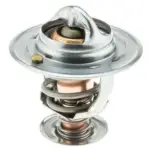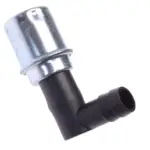Most gasoline engines use Coil-on-plug (COP) ignition systems. A coil-on-plug system is basically exactly what it sounds like. A coil rests on top of the spark plug on the engine. Each spark plug has its on coil sitting on top of it. This really cuts down on the wiring needed for the ignition system, heat shields, and COP offers better reliability than other ignition systems. That is just a few of the reasons that coil-on-plug systems are being used more and more in the automotive industry.

Because each spark plug has its on coil, the coils have more time between each firing. This increases coil saturation time (the time the voltage to the coil is energized to build up its magnetic field). It also increases coil output voltage at high rpm. This is good because misfire is most likely to occur under high rpm or under high loads. Increased voltage increases the spark plugs ability to ignite the fuel in the cylinder.
Most COP ignition systems are located on the top of the engines right on top of the spark plugs. This is ideal because it keeps the coils away from the heat of the exhaust. Some engines do not have COP ignitions because the location of the spark plugs does not have enough clearance for the coils, or the spark plugs are located too close to the exhaust.
How Coil-On-Plug Ignition System Works
The most important jobs of the ignition system is igniting the fuel in the cylinder at the correct time. A COP system utilizes a crankshaft position (CKP) sensor to determine when to ignite. The sensor determines what stroke each piston is in either intake, compression, combustion, or exhaust. The coil will be energized for the combustion cycle. The CPK sensor generates a signal by reading notches on either the crankshaft or the flywheel. The crank sensor sends its signal to the PCM (power-train control module). The PCM then decides the firing order and time of when to turn the ignition coils on or off.
In the event of an engine stall, the PCM will stop receiving signals from the crankshaft and camshaft position sensors and it will shutdown the ignition system. PCM will also de-energize the auto shutdown relay. This relay will then cut off the fuel injectors. With the ignition system and fuel injectors both offline, the engine is safely shutdown. PCM will also de-energize the fuel pump relay shutting down the fuel pump.
Each coil on the engine has a low primary resistance, generally less than 2 ohm, and has a primary system voltage from to 12 volts to 40,000 volts. This high voltage is needed by the spark plug to produce a spark.
The advantage of a COP system is that the coil is directly above the plug. The voltage from the coil goes directly into the plug electrodes without having to pass through long wires. This helps to deliver hotter sparks than a distributor system.
Ignition System Issues
While there are many benefits to COP systems, they are still susceptible to issues such as: misfiring, hard starts, or not starting at all. Spark plugs can still get fouled by fuel or oil. Pre-ignition and detonation can also occur.
If the engine is not starting, it’s possible that the crankshaft position sensor has failed. Without this sensor the PCM will not know when to ignite the coils, and since the PCM doesn’t know when to tell the coils to energize, it won’t energize them at all.
If the engine is misfiring, the problem could lie within the driver circuit of the PCM. A faulty circuit could prohibit individual coils from energizing. Since each spark plug has its own individual coil, the misfire should be isolated to one cylinder. Engines can still suffer from fouled spark plugs, damaged coils, or connectors. Improper fuel pressure, vacuum leaks, loss of compression in a cylinder, clogged fuel injectors. All of these should be investigated prior to replacing the COP ignition system. Common engine codes for COP system issues are P0300’s. These codes may indicate a problem in a particular cylinder. However if the code is P0300 then it is probably a vacuum leak or fuel system issue (injector, fuel pressure, etc) and not ignition related.
Certain codes such as P0304 may indicate that the issue could be related to a fouled spark plug, a faulty coil, or dirty fuel injector. Sometimes this code can also be related to a loss of compression in the cylinder. If the misfire is because of a bad coil, there will be a coil code that corresponds to the cylinder code (for example P0351 to P0358).
Sometimes the engine will crank but it will not start. In these cases the issue could be with the crankshaft position sensor. The sensor could be reporting the crankshaft position inaccurately causing the PCM to energize the coils at the wrong time, resulting in no combustion. A failed crankshaft position sensor will have the code P0320. If the issue is the camshaft position sensor, the PCM will have difficulty controlling the fuel injectors because it won’t know when the intake valves are open or closed. If you have this issue, your vehicle may still start, but it won’t run well. In many cases, the engine will only run in limp mode with this issue.
How To Test Coil-On-Plug Ignition Systems
There is an easy way to test coil-on-plug systems with a multimeter. Each coil as a primary and secondary circuits. You’ll have to check the resistance of both circuits. To start, connect the positive and negative pins of your multimeter to the terminals on the coil. The primary resistance should be somewhere between 0.4 and 2 ohms. However, it is best practice to refer to the manufacturer’s specifications for the correct resistance reading. If the multimeter reads 0 ohms then that is signaling that the ignition coil has a short somewhere internally and needs to be replaced. If the multimeter displays a resistance much higher than specification it should also be replaced.
Now to inspect the secondary circuit connect the multimeter to the positive terminal of the coil and connect to the high output terminal. The high output terminal is the terminal that goes to the spark plug. This resistance reading should be anywhere from 6,000 ohms to 10,000 ohms. Again, we recommend referring to the manufacturer’s specification to determine the resistance ranges. A resistance reading of 0 ohms indicates that the coil is shorted and needs to be replaced. If the resistance is excessively higher than specification, this indicates an open circuit and the coil should be replaced.
When inspecting the ignition coils, it is important to remember to reconnect all terminals after inspection. Also inspect the wiring to the ignition coils for wear, and it is a good idea to check the case of the ignition coil for damage. If you find any damage or cracks, be sure to repair or replace the components immediately as required.



